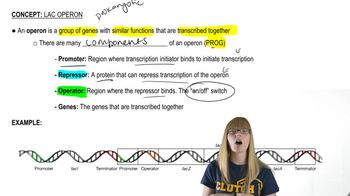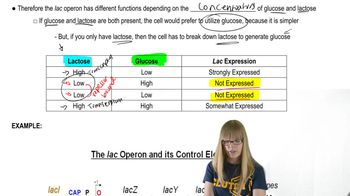Table of contents
- 1. Introduction to Genetics51m
- 2. Mendel's Laws of Inheritance3h 37m
- 3. Extensions to Mendelian Inheritance2h 41m
- 4. Genetic Mapping and Linkage2h 28m
- 5. Genetics of Bacteria and Viruses1h 21m
- 6. Chromosomal Variation1h 48m
- 7. DNA and Chromosome Structure56m
- 8. DNA Replication1h 10m
- 9. Mitosis and Meiosis1h 34m
- 10. Transcription1h 0m
- 11. Translation58m
- 12. Gene Regulation in Prokaryotes1h 19m
- 13. Gene Regulation in Eukaryotes44m
- 14. Genetic Control of Development44m
- 15. Genomes and Genomics1h 50m
- 16. Transposable Elements47m
- 17. Mutation, Repair, and Recombination1h 6m
- 18. Molecular Genetic Tools19m
- 19. Cancer Genetics29m
- 20. Quantitative Genetics1h 26m
- 21. Population Genetics50m
- 22. Evolutionary Genetics29m
12. Gene Regulation in Prokaryotes
Lac Operon
Problem 9a
Textbook Question
What role does cAMP play in transcription of lac operon genes? What role does CAP play in transcription of lac operon genes?
 Verified step by step guidance
Verified step by step guidance1
Understand the lac operon: The lac operon is a set of genes in E. coli that are involved in the metabolism of lactose. It includes genes like lacZ, lacY, and lacA, which are transcribed together as a single mRNA.
Role of cAMP: Cyclic AMP (cAMP) is a signaling molecule that accumulates when glucose levels are low. It binds to the catabolite activator protein (CAP), forming a cAMP-CAP complex.
Role of CAP: CAP is a regulatory protein that, when bound to cAMP, can bind to a specific site near the lac operon promoter. This binding enhances the binding of RNA polymerase to the promoter, increasing transcription of the lac operon genes.
cAMP-CAP complex: The cAMP-CAP complex acts as a positive regulator of the lac operon. In the absence of glucose, the increased levels of cAMP lead to more cAMP-CAP complexes, which in turn increase the transcription of the lac operon.
Integration of signals: The lac operon is regulated by both the presence of lactose (which removes the repressor) and the absence of glucose (which increases cAMP levels). This dual regulation ensures that the operon is expressed only when lactose is available and glucose is not, optimizing energy use.
Recommended similar problem, with video answer:
 Verified Solution
Verified SolutionThis video solution was recommended by our tutors as helpful for the problem above
Video duration:
2mPlay a video:
Was this helpful?
Key Concepts
Here are the essential concepts you must grasp in order to answer the question correctly.
cAMP (cyclic Adenosine Monophosphate)
cAMP is a secondary messenger important in cellular signaling. In the context of the lac operon, cAMP levels increase when glucose is scarce, leading to the activation of the transcription of lactose-utilizing genes. It binds to the CAP protein, facilitating the recruitment of RNA polymerase to the promoter region of the operon, thus enhancing transcription.
Recommended video:
Guided course

Lac Operon Regulation
CAP (Catabolite Activator Protein)
CAP is a transcriptional activator that binds to the cAMP-cAMP complex. When glucose levels are low, cAMP levels rise, allowing CAP to bind to the promoter of the lac operon. This binding enhances the affinity of RNA polymerase for the promoter, promoting the transcription of genes necessary for lactose metabolism.
Recommended video:
Guided course

Proteins
lac Operon Regulation
The lac operon is a classic example of gene regulation in prokaryotes, specifically in E. coli. It consists of genes required for the metabolism of lactose and is regulated by the presence of glucose and lactose. The interplay between cAMP, CAP, and the lac repressor determines whether the operon is active or inactive, allowing the cell to efficiently utilize available energy sources.
Recommended video:
Guided course

Lac Operon Regulation

 4:27m
4:27mWatch next
Master Lac Operon Overview with a bite sized video explanation from Kylia Goodner
Start learning


